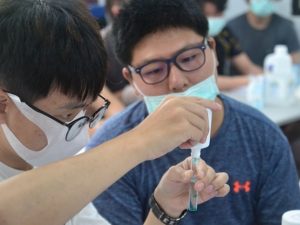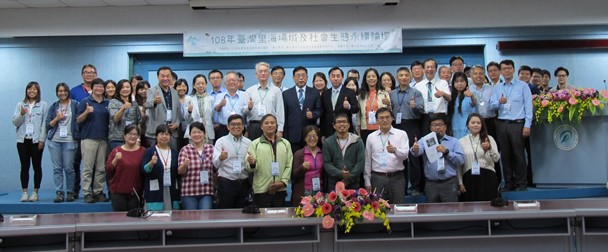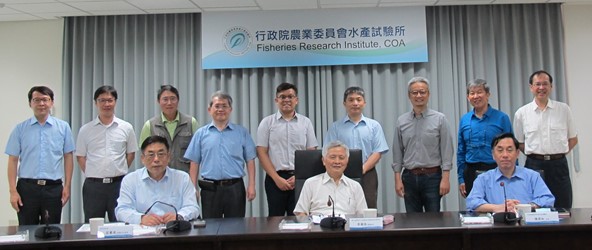Satoumi areas and networks in Taiwan: the integrity and connection among forests, rivers, human settlement and seas
15.06.2021
SUBMITTED ORGANISATION
Fisheries Research Institute, Council of Agriculture, Executive Yuan, Taiwan
OTHER CONTRIBUTED ORGANISATIONS
Partners include:
(1) Governmental agencies that can provide funding and policy supports; (2) Universities that can offer technical assistance and professional suggestions and ideas; (3) NGOs that can work collaboratively for promoting satoumi, such as community development associations, local organizations, and fishers’ associations.
DATE OF SUBMISSION
15/06/2021
REGION
Asia
COUNTRY
Chinese Taipei
KEYWORDS
Satoumi, coastal ecosystem, environmental education, sustainable fishery, collaborative governance
AUTHOR(S)
Dr. Chen, Jyun-Long (Brad)- Associate Researcher, Fisheries Research Institute, Council of Agriculture, Taiwan (R.O.C.)
Mr. Hsu, Kang (Gordon)- Research Assistant, Fisheries Research Institute, Council of Agriculture, Taiwan (R.O.C.)
Summary Sheet
The summary sheet for this case study is available here.
Rationale
Since 2011, the Forestry Bureau of the Council of Agriculture has been working with public sectors, universities, nonprofit organizations, and local communities on ecological restoration of critical habitats and ecosystem services in low-elevation mountainous ecosystems (e.g., rice terraces and wetlands) based on the Satoyama Initiative. However, concerning the governance of ecosystem services of river basins and the integrity and connection among forests, rivers, human settlements, and seas in natural and rural areas of Taiwan, integrated approaches to conservation, revitalization, and sustainability are critical. Therefore, the roles and functions of rural areas in Taiwan, especially in coastal areas, must be re-examined. Because the fishing industry was traditionally based in harbors, fishing settlements gradually expanded to the surrounding areas. This resulted in clusters of fishing communities with well-established roots, which are typical for Taiwan’s coastal regions. Coastal fishery is a major source of income and livelihood for local communities along the coast, and local people must consider how to respond to current developmental trends centered on resource conservation management and the integration of local industrial development. Since 2019, the Fisheries Research Institute (the FRI) has been involved in the policy program “Establishment of a National Ecological Conservation Green Network” (promoted by the Council of Agriculture), which aids the development of satoumi and enhances the sustainability of fishing villages.
Objectives
The FRI has accumulated long-term experience in research and development for fisheries and has expertise and human resources for practical consultation. In recent years, the FRI’s researchers cooperate in the aforementioned policy program and are engaged in building partnerships with other organizations. In the meantime, researchers have begun promoting the concept of satoumi development. FRI’s participation bridged the gap in resource inventory and practical consultation in coastal fishing communities. The FRI introduced participatory methods for interacting with local communities. The promotion of satoumi areas relies not only on official funds and policy support but also entails the consideration of local characteristics and the demands of residents. This strengthens the cooperation with and partnership of fishers’ associations, fishing communities, and other organizations in the area. Additional tasks are enhancing local communities’ capacity for environmental education and strengthening community resilience as well as protecting local traditional cultures. The central tenet of satoumi is the synergetic coexistence of humans and nature within the areas of coastal ecosystems. In the context of the Sustainable Development Goals (SDGs), the FRI emphasizes SDG 14 (importance of life below water), SDG 8 (economic growth), SDG 12 (responsible production), and SDG 11 (sustainable communities and society). Concerning these goals, the environmental, social, and economic aspects in the coastal communities can be integrated. Overall, the objectives of this project include: (1) to foster integration of communities and ecosystems to achieve a harmonious situation within specific socio-ecological systems in downstream and coastal areas; (2) to create social capital and facilitate sustainable development in the fishing villages.
Activities and practices employed
The FRI has cooperated with several governmental and non-governmental organizations to implement the aforementioned policy program. We have cooperated with National Cheng Kung University and National Taiwan Ocean University to conduct investigations and field surveys in Mao’ao and Dong’ao communities. Through conducting workshops, we identified pertinent concerns and facilitated a process of consensus-finding. Subsequently, we introduced external resources such as the “Taiwan Association for Marine Environment and Education” and a social enterprise called “Small Community, Big Issue” to cooperate in promoting satoumi education and fishery citizen science (Figure 1). Furthermore, after analyzing the findings obtained through the aforementioned activities, we compiled lesson plans on satoumi education to be used as examples in potential satoumi areas.


Figure 1. Diverse satoumi lesson plans comprising environmental educations and citizen science were designed for the communities
The FRI is recognized as a major supplier of technology and knowledge concerning fishery. Now, it aims to promote the concept of satoumi among coastal fishing communities and encourage conservation and development. Our roadmap for developing satoumi comprises three stages, each with distinct actions (Figure 2):
Stage 1: Planning and call to action
- Develop the “Indicators of Socioecological Systems in Taiwan’s Coastal Fishing Communities” ;
- Evaluate the current status and potential of 28 communities relevant to satoumi and assess the social-ecological production landscape and seascapes (SEPLS) nearby those coastal communities;
- Conduct “Satoumi Workshops for Sustainable Development” and the “Taiwan Satoumi Areas and Socioecological Sustainability Forum” to elicit the diverse voices of local people and share relevant practical experience;
- Evaluate and designate key satoumi areas for implementing a participatory action approach.
Stage 2: On-site practical implementation
- Conduct focus-group meetings to open up multiple communication channels and discuss the development strategies for key satoumi areas;
- Apply practical consultation to key satoumi areas to enable satoumi-related industrial value-added activities;
- Empower local people in key satoumi areas and implement environmental education and citizen science to raise awareness of marine environmental conditions and encourage taking action.
Stage 3: Extension and outreach to the public
- Create a “Satoumi Information Platform” for broader dissemination of the satoumi concept and relevant case studies;
- Nurture relevant talent, recruit teams to promote satoumi education, and build a human-resources database;
- Assist the communities in satoumi areas to implement satoumi environmental education and use relevant teaching aids;
- Encourage exchange and visitations among communities in satoumi areas to facilitate the sharing of experience to accumulated social capital;
- Expand local participation in satoumi to nationwide public participation.

Figure 2. Three stages of developing satoumi and the activities for each stage
Results
Stage 1 (2019):
To develop satoumi areas in Taiwan, defining satoumi at the initial stage is paramount. Therefore, we established the indicators for evaluating satoumi areas according to international researches (Duraiappah & Nakamura, 2013; IPSI Secretariat, 2015; Japan Satoyama Satoumi Assessment, 2010; Tsukamoto et al., 2008) and “The Guidebook for Creating Satoumi (里海づくりの手引書)” (Ministry of the Environment, 2011). Subsequently, field surveys and workshops were implemented at 28 potential satoumi areas across Taiwan (Figure 3).

Figure 3. Locations of 28 potential satoumi areas in Taiwan
We identified problems and analyzed the socioecological status of each potential area by interacting with and understanding the local stakeholders and incorporating the information obtained from the field survey. Eventually, the potential areas were chosen as Taiwan’s satoumi demonstration sites. Furthermore, we collected more crucial opinions and suggestions from experts and participants through conducting the “Taiwan Satoumi Areas and Socioecological Sustainability Forum” (Figure 4). The obtained findings became the foundations for the future development and realization of the satoumi initiative in Taiwan.


Figure 4. Forum and focus group meeting for discussing the development of satoumi in Taiwan
The photo on the left shows the participants of the “Forum of Satoumi Areas and Socioecological Sustainability in Taiwan” conducted by the FRI in October, 2019. Participants represented government, industry, NGOs, and communities with an interest in the topic. The photo on the right shows the participants of the focus group meeting of experts discussing the concept of satoumi and its suitability in the context of Taiwan.
Stage 2 (2020):
The second stage began in 2020 with practical consultation in the field. Our main activity comprised the following processes:
- Knowledge facilitation
Practical consultation through preliminary interviews and three focus group meetings at each site was conducted to understand the needs and current situation of the community, and expert meetings were conducted to determine the strategies of satoumi development.
- Capacity building
After understanding and evaluating local social and ecological resources, we planned and organized satoumi environmental education courses for the satoumi demonstration areas such as guide training, water quality assessment, and participatory intertidal ecological surveys.
- On-site practical implementation
In 2020, follow-up activities were conducted. These included training courses enabling locals to conduct participatory intertidal ecological surveys, establish a fish-catch reporting system, and develop satoumi-related industries.
By implementing community empowerment and providing satoumi environmental education courses, we expect to produce fishery production and resource-related data enabling long-term investigation and fishery monitoring (Figure 5 & Table. 1).

Figure 5. An example of catch composition of set-net fishery recorded by local people in Dong’ao community

Table. 1. An example of a daily record of caught species from set-net fishery in Dong’ao Bay
On October 24, 2020, the FRI conducted an inaugural event in Dong’ao community. Local residents, fishers, representatives from the leisure industry and schools as well as other stakeholders joined a program that included a beach cleanup activity, bamboo raft launching ceremony, guidance and interpretation concerning set-net fishing and fish species, storytelling about the fishing community’s history, and a fish auction. On November 9, a satoumi environmental education activity was conducted in Mao’ao community in cooperation with the Taiwan Association for Marine Environment and Education and the local elementary school. The activity included coral assessment and intertidal zone observation and record-keeping. The community integrated its satoumi environmental education lesson plan and experience activities into community reception services. This activity offered a beneficial opportunity for Mao’ao community to develop a model comprising both environmental education and industrial development.
From the experience in Mao’ao and Dong’ao communities, we believe that local awareness and organizational capacity are increasing. In addition, local fishing culture and ecosystem services are supported through the idea of “local production for local consumption.” The ongoing works with these satoumi areas and the experience we have obtained constitute a practical methodology for the expansion of satoumi in Taiwan.
Lessons learned
We found that the autonomous participation of fishers and local people played a crucial role. Therefore, the promotion of citizen science in fishery and the development of environmental education were applied to train talents and build capacity in local communities. In addition, community participation in a fishery co-management model was gradually introduced. To achieve long-term sustainable coexistence in social, economic, and environmental aspects, a diverse and inclusive communication model should be established at the local level as soon as possible to allow stakeholders to recognize the value of local traditions, knowledge, and cultures (Figure 6).
Through the experience from studying the satoumi sites, the regional experiences will gradually be developed into a set of feasible promotion criteria and guidelines and be used as the basis for the national satoumi education and research network. The development of the satoumi sites with a sustainable concept is expected to lead to an opportunity for the revitalization and development of coastal fishing communities in Taiwan.

Figure 6 The ‘Ama, あま’ used their traditional knowledge to harvest seaweed in the inter-tidal zone in northeastern Taiwan
Key messages
To promote the satoumi initiative in Taiwan, the FRI aimed to identify a mutually beneficial relationship between humans and nature that is not only environmental resources but also encourages sustainable economic development in coastal areas. At the first stage, in 2019, we identified problems and analyzed the social-ecological status of 28 potential satoumi areas across Taiwan. In addition, we conducted forums to discuss the concept of satoumi and its suitability in the context of Taiwan. At the second stage, in 2020, we focused on interacting with and understanding the local stakeholders and incorporating the information obtained from the on-site practical implementation at the model sites by conducting field surveys, in-depth interviews, secondary data analysis, focus group meetings, and questionnaire surveys. Furthermore, practical consultation in the field, satoumi environmental education courses, and citizen scientist’s empowerment were implemented. Over 70 public–private sector partnerships and NGOs and over 800 individuals have participated directly or indirectly in the process until now. Our study yielded the following outcomes:
- By adopting diverse patterns of communication through interviews and focus group meetings among local stakeholders and holding forum and expert-meetings, we conclude that these techniques are helpful for encouraging interaction with stakeholders, finding consensus, and intensifying the partnership of the local and involved organizations. In summary, the applied techniques are useful for developing strategies for the advancement of satoumi initiatives.
- The community empowerment courses included ecological, environmental, and industrial development. In addition, the content of the courses was based on local awareness and the results of conducting local resource inventories. This increased the willingness to participate among community members.
- The introduction of satoumi environmental education and citizen science courses to residents in the communities increased their awareness of the condition of the marine environment and encouraged them to take precautionary measures.
- By providing practical methods for acquiring knowledge concerning marine resources and fishery management, community members are encouraged to continuously promote satoumi.
- The satoumi education lesson plans offer an opportunity for fishing communities to promote their fishing culture, local ecological knowledge, and related ecosystem services.
Based on our promotion and the aforementioned activities, local people are now partly involved in satoumi-related activities. We hope that local people and stakeholders will cooperate with each other in co-managing coastal ecosystems and their communities in the near future. The ongoing work of the FRI involves creating a “Satoumi Information Platform” not only for broader dissemination of the satoumi concept and case studies but also for creating a space for facilitating the cooperation of cross-government bodies in promoting satoumi activities in more comprehensive and diverse manners. Crucially, enhancing human resources, for example, by nurturing young talents and by recruiting a “satoumi extension task force,” and drawing public attention to coastal areas are two pivotal tasks. Finally, the blueprint of practical methodology for the advancement of satoumi adopted by the FRI will be widely extended to other fishing communities and coastal ecosystems.
Relationship to other IPSI activities
The FRI maintains a partnership between Taiwanese IPSI members such as National Dong-Hwa University, Hualien District Agricultural Research and Extension Station, and the Forestry Bureau. These IPSI partners focus mainly on SEPLS in agriculture and forested areas such as forests and farmlands. In addition, the FRI focuses on ocean-based activities and livelihoods that are both affected by and affect complex interactions among ecological, social, and economic systems in coastal zones. The interactions between the FRI and Taiwanese IPSI members involve exchanging opinions and experience concerning satoyama advancement and assisting in the governance in satoumi areas. Now, the FRI is promoting the concept of satoumi to coastal fishing communities and trying to improve conservation and the development of fishing communities and their environments.
Funding
For this case study, the funding for promoting satoumi was provided by government bodies (Establishment of a National Ecological Conservation Green Network). All individuals involved in this work are from the government, industry, academia, and NGOs, and the communities in the satoumi areas.
Reference
Chen, J. L., Hsu, K., Chuang, C. T. (2020). How do fishery resources enhance the development of coastal fishing communities: Lessons learned from a community-based sea farming project in Taiwan. Ocean & Coastal Management, 184, 105015.
Chuang, C.T., 2015. Socio-Economic Investigation and Operation Management Framework Arrangement for Fish Farming Demonstration Zone in Taiwan. Project Report of Fisheries Agency (Abstract in English).
Duraiappah, A. K., & Nakamura, K. (2013). The Japan Satoyama Satoumi Assessment: objectives, focus and approach. Satoyama-Satoumi Ecosystems Human Well-Being, 1-16.
IPSI Secretariat (2015). IPSI Handbook: The International Partnership for the Satoyama Initiative (IPSI) Charter, Operational Guidelines, Strategy, Plan of Action 2013-2018.
Japan Satoyama Satoumi Assessment (2010). Satoyama-Satoumi Ecosystems and Human Well-being: Socio-ecological Production Landscapes of Japan – Summary for Decision Makers. United Nations University, Tokyo, Japan.
Liu, H.H., Chuang, C.T., Chiu, S.T. (2001). An Application of Fuzzy Multi-criteria Decision Method in Evaluating the Performance of Flourishing Fishing Community Development and Planning. Taiwan. Agric. Econ. Rev. 7 (1), 63–99 (abstract in English).
Ministry of the Environment (2011). The Guidebook for Creating Satoumi (里海づくりの 手引書), 109. Retrieved from: https://www.env.go.jp/water/heisa/satoumi/common/satoumi_manual_all.pdf
Wang, S. B., Chen, W. K., & Joung, S. J. (2013). Seasonal dynamics of flatfish assemblage in coastal waters off northeastern Taiwan: With implications for shift in species dominance of the ecosystem. Journal of Marine Science and Technology, 21, 23–30. https://doi.org/10.6119/JMST-013-1219-4.
Tsukamoto, K., Kawamura, T., Takeuchi, T., Beard Jr, T. D., & Kaiser, M. J. (2008). “Sato-Umi”—A New Concept for Sustainable Fisheries. Fisheries for Global Welfare and Environment, 351.

